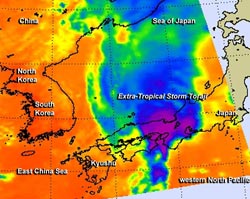Infrared NASA Image Sees Extra-Tropical Toraji Over Japan

NASA's AIRS instrument data took this infrared image of Tropical Storm Toraji as it continued tracking through southern Japan on Sept.4 at 0429 UTC. Purple indicate coldest cloud top temperatures and strongest thunderstorms with heaviest rainfall. Image Credit: NASA JPL/Ed Olsen<br>
The Atmospheric Infrared Sounder or AIRS instrument captured infrared data of Extra-Tropical Storm Toraji as it continued tracking through southern Japan on Sept.4 at 0429 UTC/12:29 a.m. EDT.
AIRS showed that the coldest cloud top temperatures and strongest thunderstorms with heaviest rainfall stretched from Hyogo Prefecture in the southwest to Shiga Prefecture to Gifo Prefecture in the northeast.
At 1500 UTC/11 a.m. EDT on Sept. 4, Toraji had maximum sustained winds near 40 knots/46 mph/74 kph. It was centered near 32.7 north and 132.9 east, about 114 nautical miles/131 miles/211 km south of Iwakuni, Japan. Toraji has increased in forward speed over the last day and was moving to the northeast at 22 knots/25.3 mph/40.7 kph.
The Joint Typhoon Warning Center's multi-level analyses indicated that Toraji is now an extra-tropical cold-core low pressure area, and it is linked to a fast moving frontal boundary. That frontal system is moving across Japan and will carry Toraji's energy with it.
Text credit: Rob Gutro
NASA's Goddard Space Flight Center
Media Contact
All latest news from the category: Earth Sciences
Earth Sciences (also referred to as Geosciences), which deals with basic issues surrounding our planet, plays a vital role in the area of energy and raw materials supply.
Earth Sciences comprises subjects such as geology, geography, geological informatics, paleontology, mineralogy, petrography, crystallography, geophysics, geodesy, glaciology, cartography, photogrammetry, meteorology and seismology, early-warning systems, earthquake research and polar research.
Newest articles

Sea slugs inspire highly stretchable biomedical sensor
USC Viterbi School of Engineering researcher Hangbo Zhao presents findings on highly stretchable and customizable microneedles for application in fields including neuroscience, tissue engineering, and wearable bioelectronics. The revolution in…

Twisting and binding matter waves with photons in a cavity
Precisely measuring the energy states of individual atoms has been a historical challenge for physicists due to atomic recoil. When an atom interacts with a photon, the atom “recoils” in…

Nanotubes, nanoparticles, and antibodies detect tiny amounts of fentanyl
New sensor is six orders of magnitude more sensitive than the next best thing. A research team at Pitt led by Alexander Star, a chemistry professor in the Kenneth P. Dietrich…





















